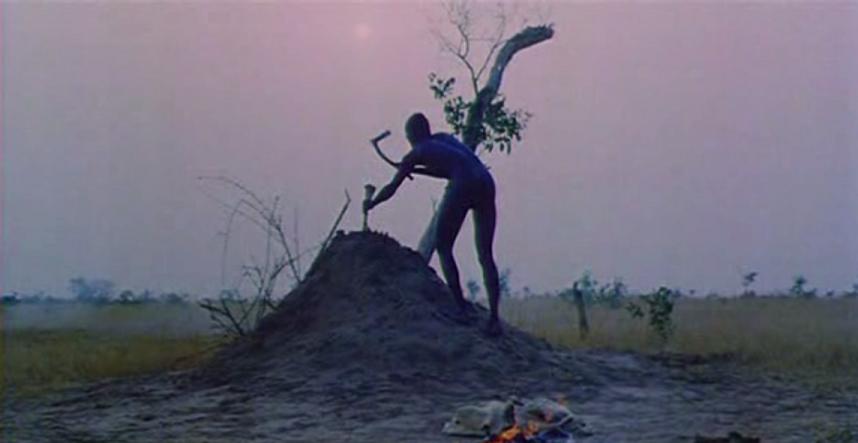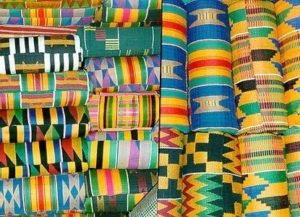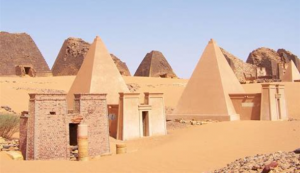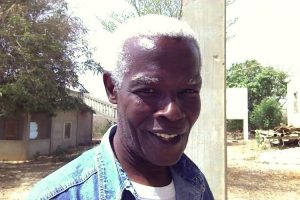In a recent conversation I had with a friend who had just spent some time in the villages of the Faroe Islands in early 2020, I was struck when he mentioned about the traditional spiritual practice of the region. He told me that the “hidden people” in the region are known to live in stone. He did not mean it in an allegorical, mythical or symbolic way. This was literal. The spirits literally live in stone.
Now, among the Akan, it is well-known that spirits can live in rocks, in mountains and also in mounds specially prepared for them. In fact, spirits can also live in trees, in water bodies, and within the essence of fire and air. This knowledge is not unique to the Akan, or even to Africans. It is found in indigenous traditions of people all over the world. So I was not surprised to learn that people in the remote Faroe Islands also know about the “hidden people” living in stones.
Now to discuss Akan and Siberian spirituality. One may wonder what Akan (and by extention some other African) spiritual practices will have in common with the traditional spiritual practices of the Siberians. Through my studies I have come across some similarities but also some wide differences in the practices of each people. The Siberian cluster of ethnic groups is sufficiently diverse so that different ethnic groups have spiritual practices which are not always identical. One group in particular which I want to focus on in this article are the Buryats. While reading the book Aboriginal Siberia: A Study in Social Anthropology, written by Polish-British anthropologist Maria Antonina Czaplicka, I came across work done by a Buryat anthropologist called Dorji Banzaroff, sometimes spelt differently by Russians. This work is entitled The Black Faith or Shamanism among the Mongols and as I read it, I became really interested in learning more about what this author wrote. The original paper was a masters thesis written in the 1840s. Unfortunately, Banzaroff did not live long enough to do more research in this direction (b.1822, d.1855).
What interested me about Banzaroff’s work were the parallels between Akan and Buryat practices relating to ancestral spirits and to the creation of ‘spirit mounds’ for nature spirits. Both practices are very similar, if not identical. In addition, Buryats call their spirit mount an ‘oboo’. This is made from stones and dirt and is used to house a territorial spirit. Among the Akan, the word for stone is …’obo’! And the phrase for the reverence/worship of nature spirits is ‘obo-som’! (literally, ‘stone worship’). This phrase then evolved into a word that referred to all nature spirits as ‘obosom’ or ‘abosom’…the worship of the divinities. For me, this is remarkable.
Later on I learned more about the Siberian (Buryat) shamanism written by Banzaroff in a book by Andrei Znamenski entitled Shamanism in Siberia (2003). Here are some excerpts I have selected from the book that highlight what Znamenski wrote in relation to Banzaroff and to his discussion of aspects of Siberian Shamanism:
“According to Banzarov, his work is the first “systematic and full description of the Black Faith” of the Mongols. The ancient popular religion of the Mongols and neighbouring natives is known in Europe under the name of shamanism. However, the carriers of this religion do not have any special name for it. After they adopted Buddhism, the Mongols started to call it the “Black Faith”, which means “crude, unenlightened” faith as opposed to Buddhism, the “Yellow Faith”. One of the supreme deities in Mongol shamanism, the heavenly ruler of the world, is a male deity. The second supreme deity is the earth, which is represented by the goddess Etugen“. (p. 67)
“In heaven there are a large number of secondary deities called tengeri. They symbolize celestial phenomena and human passions.” (p.68)
“Banzarov also describes how the Mongols revered sacred places called obo. The obo play the role of local temples where people bring their sacrifices to the deities and spirits of the locality they reside in. In old times, the construction of the obo and the sacrifices to obo were simple. A shaman usually announced that spirits who were patrons of a hill or a mountain selected this specific locality as their residence. Then, at a designated place, people erected obo, a small pile of stones and dirt, and performed proper rituals in honor of a territorial spirit. Obo are usually erected next to roads for travelers to place on them some object as a sacrifice. The Mongols believe that the spirit of a locality resides in an obo.” (p. 68)
“Banzarov discusses the special category of deities (ongons), which originated from the cult of ancestors. In ancient times, when people died, their relatives made their images called ongons, kept them at home and “fed” them with regular sacrifices. Later some ongons evolved into common clan deities and became separated into good and hostile ongons….Whose soul becomes an ongon is for a shaman to define. Not everybody can become an ongon. Only those who were famous for their good or bad deeds can become embodied in such images. Those who provided substantial help and benefit to people become good ongons, while famous evil ones become hostile ongons.” (p.69)
“The first shamans were “people of special spiritual inclinations.” They “differed from regular people by their abilities to experience visions and were extraordinarily prone to all things mystical and miraculous. They were endowed with a flaming imagination and a knowledge of powers of nature”. To the present day, shamans are divided into false and genuine spiritual practitioners. The former adopt this vocation to pursue personal benefit. Such people do not have any authentic shamanic qualities. On the contrary, “genuine shamans” “do not choose their vocation; they are driven by a natural force or a call; from early childhood such a person exhibits a tense agitated spirit”. Native people interpret this as the activities of supernatural forces.” (p. 70).
Akan and other west Africans make spiritual mounds in the same way as the Buryats do. This is the case in Ghana, in Burkina Faso, in Togo, in Benin, in Cote d’Ivoire, in Mali, in Nigeria and in many other places across West Africa and beyond. So it is a very interesting parallel. The way ‘ongons’ are fed is also similar to how the Akan ‘feed’ the ‘black stools’ of the ancestors during festivals and on other important occasions.
Another source of information that intrigued me was a set of notes written by a shaman called Sarangerel where she classifies the Natural world of the Siberian Shaman into these five aspects:
1) Father Sky, Mother Earth
2) The Ancestors
3) Tenger, Chotgor and other Nature Spirits
4) Spirits of Animals, Totems, Animal Guides and Hunting
5) Sacred Mountains and Trees
In this classification, the natural world view of the Siberian shaman is almost identical to that of the Akan. This is seen during our libation ceremonies. We always start by addressing Divine Providence. Next is to address the Earth (Asase Yaa), then next we invite the ancestors and the abosom (nature spirits) before going on to make the prayer. I have not found a more similar classification with other native groups, so this was interesting to me.
The Siberian shaman also uses trees to access the upper and lower worlds. This is the case in Akan witchcraft as well. Below are some notes I made from Debrunner’s book Witchcraft in Ghana when I read it some years ago:
USING THE ENERGY OF TREES TO TRAVEL THROUGH THE SPIRITUAL REALMS
From Debrunner:
The trees that witches meet on are: Silk Cotton (Onyaa), Odum, Wawa, Ofram and Mahogany (rarely). Odum and Silk Cotton are most frequently used. It is said that wood of Silk Cotton is used on sorcery, that evil persons can shapeshift into a Silk Cotton tree. Also, tutelar spirits reveal themselves at big silk cotton trees in the forest. The big tree may be said to provide “the natural gateway/highway of the traffic between worlds and traffic above and below. Case in point: Nyame-dua (Astonia Gruensis, which is also dalled “devil’s tree” in India). In the case of Nyame-dua, it is never called a witch tree, rather “the only tree by which Nyame descends. It is god’s ladder”. Trees do not only serve as a “ladder” or an abode for a tutelar spirit, they are also considered to possess a life-soul like animals and man.
The final point I want to make here has to do with spirit possession. It seems some forms of Siberian shamanism include the possession by spirits to give the shaman power. While reading Olga Kiritidi’s book Entering the Circle, the Altaic shaman who was about to die released the spirit that was in him and had possessed him earlier on in life. This spirit was then sent to the shaman’s nephew. It is quite interesting to me because I don’t find spirit possession happen in the same way among Native Indians, whose spiritual traditions have some similarities as well as some differences with both African and Siberian shamanism.
Africa is very much at home with indigenous lore. Arabic conquest of Africa and later colonial influences did not touch Africa long enough to change this trend. Unlike Native Indians of America who have lived side-by-side with Western Europeans and Siberians who have lived side-by-side with Russians, much of Africa (and parts of Asia and the Pacific) is still very much tribal, and much of African lore and spirituality still remains very much secret and is not relegated to books, since these are still living cultures with a strong oral component.
It is my belief that African spirituality has not yet been studied in the depth and exhaustive manner that Native Indian and Siberian shamanism has been studied. In a sense this could be seen as being good for the continuation of these traditions. African spiritual traditions as a whole were not systematically oppressed by Western, Eastern, Southern or Northern Europeans as was the case in America after the explosion in popularity of the Ghost Dance (among Native American Indians) or in Siberia as was the case during parts of the Soviet era. As a result of this, the only serious competition to the continuity and development of African traditional religion came from Christianity and Islam. Nowadays we have in Africa various syncretic forms of religion which merge African traditional religion with Christianity or Islam to create midway practices between traditional and foreign.
Africa is still very much highly differentiated into ethnic groups with their unique languages and cultures. Each African country has numerous ethnic groups, languages and flavours of spirituality, and all Africans in their traditional contexts are inherently spiritual. This differentiation is what some see as a problem to political unity, however from the perspective of cultural and spiritual diversity it is great to have so much expression of different African groups. The modern world is fast eroding the Africa that existed only a few hundred years ago.

(Photo credit: Malian Movie ‘Yeelen’)



